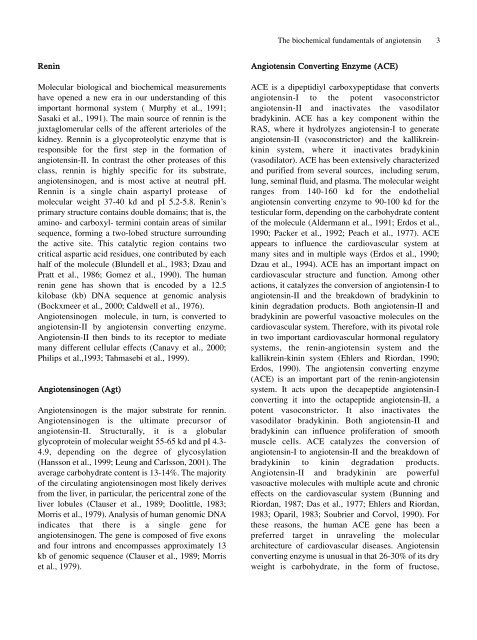Full Journal - Journal of Cell and Molecular Biology - Haliç Üniversitesi
Full Journal - Journal of Cell and Molecular Biology - Haliç Üniversitesi
Full Journal - Journal of Cell and Molecular Biology - Haliç Üniversitesi
Create successful ePaper yourself
Turn your PDF publications into a flip-book with our unique Google optimized e-Paper software.
Renin<br />
<strong>Molecular</strong> biological <strong>and</strong> biochemical measurements<br />
have opened a new era in our underst<strong>and</strong>ing <strong>of</strong> this<br />
important hormonal system ( Murphy et al., 1991;<br />
Sasaki et al., 1991). The main source <strong>of</strong> rennin is the<br />
juxtaglomerular cells <strong>of</strong> the afferent arterioles <strong>of</strong> the<br />
kidney. Rennin is a glycoproteolytic enzyme that is<br />
responsible for the first step in the formation <strong>of</strong><br />
angiotensin-II. In contrast the other proteases <strong>of</strong> this<br />
class, rennin is highly specific for its substrate,<br />
angiotensinogen, <strong>and</strong> is most active at neutral pH.<br />
Rennin is a single chain aspartyl protease <strong>of</strong><br />
molecular weight 37-40 kd <strong>and</strong> pI 5.2-5.8. Renin’s<br />
primary structure contains double domains; that is, the<br />
amino- <strong>and</strong> carboxyl- termini contain areas <strong>of</strong> similar<br />
sequence, forming a two-lobed structure surrounding<br />
the active site. This catalytic region contains two<br />
critical aspartic acid residues, one contributed by each<br />
half <strong>of</strong> the molecule (Blundell et al., 1983; Dzau <strong>and</strong><br />
Pratt et al., 1986; Gomez et al., 1990). The human<br />
renin gene has shown that is encoded by a 12.5<br />
kilobase (kb) DNA sequence at genomic analysis<br />
(Bockxmeer et al., 2000; Caldwell et al., 1976).<br />
Angiotensinogen molecule, in turn, is converted to<br />
angiotensin-II by angiotensin converting enzyme.<br />
Angiotensin-II then binds to its receptor to mediate<br />
many different cellular effects (Canavy et al., 2000;<br />
Philips et al.,1993; Tahmasebi et al., 1999).<br />
Angiotensinogen (Agt)<br />
Angiotensinogen is the major substrate for rennin.<br />
Angiotensinogen is the ultimate precursor <strong>of</strong><br />
angiotensin-II. Structurally, it is a globular<br />
glycoprotein <strong>of</strong> molecular weight 55-65 kd <strong>and</strong> pI 4.3-<br />
4.9, depending on the degree <strong>of</strong> glycosylation<br />
(Hansson et al., 1999; Leung <strong>and</strong> Carlsson, 2001). The<br />
average carbohydrate content is 13-14%. The majority<br />
<strong>of</strong> the circulating angiotensinogen most likely derives<br />
from the liver, in particular, the pericentral zone <strong>of</strong> the<br />
liver lobules (Clauser et al., 1989; Doolittle, 1983;<br />
Morris et al., 1979). Analysis <strong>of</strong> human genomic DNA<br />
indicates that there is a single gene for<br />
angiotensinogen. The gene is composed <strong>of</strong> five exons<br />
<strong>and</strong> four introns <strong>and</strong> encompasses approximately 13<br />
kb <strong>of</strong> genomic sequence (Clauser et al., 1989; Morris<br />
et al., 1979).<br />
The biochemical fundamentals <strong>of</strong> angiotensin 3<br />
Angiotensin Converting Enzyme (ACE)<br />
ACE is a dipeptidiyl carboxypeptidase that converts<br />
angiotensin-I to the potent vasoconstrictor<br />
angiotensin-II <strong>and</strong> inactivates the vasodilator<br />
bradykinin. ACE has a key component within the<br />
RAS, where it hydrolyzes angiotensin-I to generate<br />
angiotensin-II (vasoconstrictor) <strong>and</strong> the kallikreinkinin<br />
system, where it inactivates bradykinin<br />
(vasodilator). ACE has been extensively characterized<br />
<strong>and</strong> purified from several sources, including serum,<br />
lung, seminal fluid, <strong>and</strong> plasma. The molecular weight<br />
ranges from 140-160 kd for the endothelial<br />
angiotensin converting enzyme to 90-100 kd for the<br />
testicular form, depending on the carbohydrate content<br />
<strong>of</strong> the molecule (Aldermann et al., 1991; Erdos et al.,<br />
1990; Packer et al., 1992; Peach et al., 1977). ACE<br />
appears to influence the cardiovascular system at<br />
many sites <strong>and</strong> in multiple ways (Erdos et al., 1990;<br />
Dzau et al., 1994). ACE has an important impact on<br />
cardiovascular structure <strong>and</strong> function. Among other<br />
actions, it catalyzes the conversion <strong>of</strong> angiotensin-I to<br />
angiotensin-II <strong>and</strong> the breakdown <strong>of</strong> bradykinin to<br />
kinin degradation products. Both angiotensin-II <strong>and</strong><br />
bradykinin are powerful vasoactive molecules on the<br />
cardiovascular system. Therefore, with its pivotal role<br />
in two important cardiovascular hormonal regulatory<br />
systems, the renin-angiotensin system <strong>and</strong> the<br />
kallikrein-kinin system (Ehlers <strong>and</strong> Riordan, 1990;<br />
Erdos, 1990). The angiotensin converting enzyme<br />
(ACE) is an important part <strong>of</strong> the renin-angiotensin<br />
system. It acts upon the decapeptide angiotensin-I<br />
converting it into the octapeptide angiotensin-II, a<br />
potent vasoconstrictor. It also inactivates the<br />
vasodilator bradykinin. Both angiotensin-II <strong>and</strong><br />
bradykinin can influence proliferation <strong>of</strong> smooth<br />
muscle cells. ACE catalyzes the conversion <strong>of</strong><br />
angiotensin-I to angiotensin-II <strong>and</strong> the breakdown <strong>of</strong><br />
bradykinin to kinin degradation products.<br />
Angiotensin-II <strong>and</strong> bradykinin are powerful<br />
vasoactive molecules with multiple acute <strong>and</strong> chronic<br />
effects on the cardiovascular system (Bunning <strong>and</strong><br />
Riordan, 1987; Das et al., 1977; Ehlers <strong>and</strong> Riordan,<br />
1983; Oparil, 1983; Soubrier <strong>and</strong> Corvol, 1990). For<br />
these reasons, the human ACE gene has been a<br />
preferred target in unraveling the molecular<br />
architecture <strong>of</strong> cardiovascular diseases. Angiotensin<br />
converting enzyme is unusual in that 26-30% <strong>of</strong> its dry<br />
weight is carbohydrate, in the form <strong>of</strong> fructose,

















